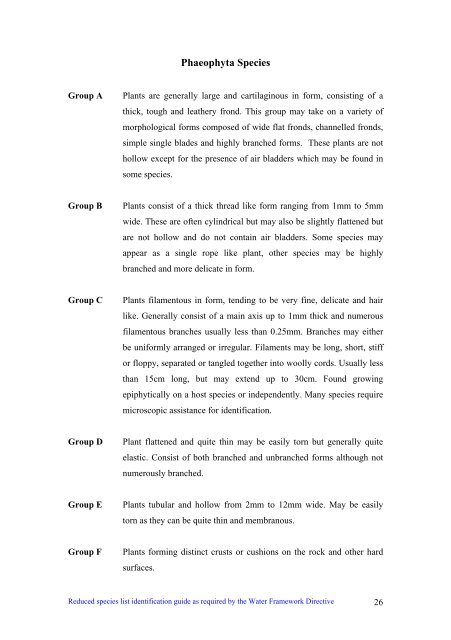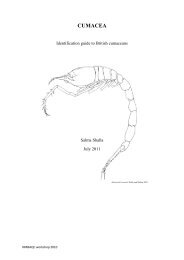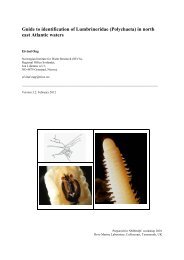s A Field Guide to the British Seaweeds - NMBAQC
s A Field Guide to the British Seaweeds - NMBAQC
s A Field Guide to the British Seaweeds - NMBAQC
You also want an ePaper? Increase the reach of your titles
YUMPU automatically turns print PDFs into web optimized ePapers that Google loves.
Phaeophyta Species<br />
Group A Plants are generally large and cartilaginous in form, consisting of a<br />
thick, <strong>to</strong>ugh and lea<strong>the</strong>ry frond. This group may take on a variety of<br />
morphological forms composed of wide flat fronds, channelled fronds,<br />
simple single blades and highly branched forms. These plants are not<br />
hollow except for <strong>the</strong> presence of air bladders which may be found in<br />
some species.<br />
Group B Plants consist of a thick thread like form ranging from 1mm <strong>to</strong> 5mm<br />
wide. These are often cylindrical but may also be slightly flattened but<br />
are not hollow and do not contain air bladders. Some species may<br />
appear as a single rope like plant, o<strong>the</strong>r species may be highly<br />
branched and more delicate in form.<br />
Group C Plants filamen<strong>to</strong>us in form, tending <strong>to</strong> be very fine, delicate and hair<br />
like. Generally consist of a main axis up <strong>to</strong> 1mm thick and numerous<br />
filamen<strong>to</strong>us branches usually less than 0.25mm. Branches may ei<strong>the</strong>r<br />
be uniformly arranged or irregular. Filaments may be long, short, stiff<br />
or floppy, separated or tangled <strong>to</strong>ge<strong>the</strong>r in<strong>to</strong> woolly cords. Usually less<br />
than 15cm long, but may extend up <strong>to</strong> 30cm. Found growing<br />
epiphytically on a host species or independently. Many species require<br />
microscopic assistance for identification.<br />
Group D Plant flattened and quite thin may be easily <strong>to</strong>rn but generally quite<br />
elastic. Consist of both branched and unbranched forms although not<br />
numerously branched.<br />
Group E Plants tubular and hollow from 2mm <strong>to</strong> 12mm wide. May be easily<br />
<strong>to</strong>rn as <strong>the</strong>y can be quite thin and membranous.<br />
Group F Plants forming distinct crusts or cushions on <strong>the</strong> rock and o<strong>the</strong>r hard<br />
surfaces.<br />
Reduced species list identification guide as required by <strong>the</strong> Water Framework Directive 26




